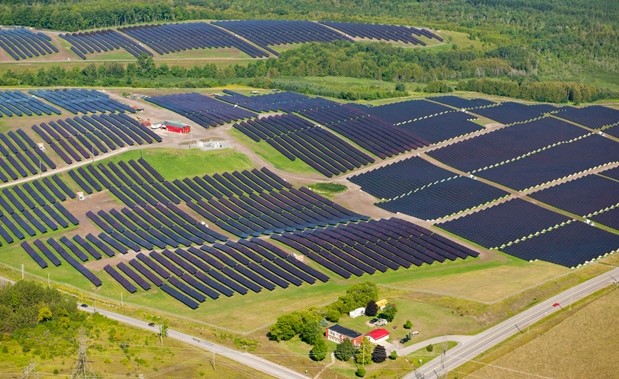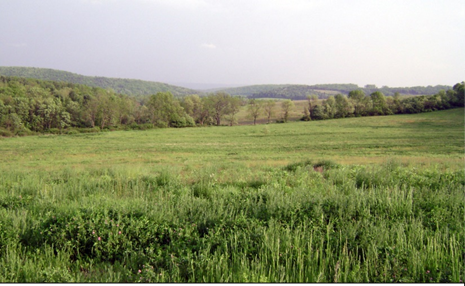Introduction
The Maryland Department of Agriculture (MDA) hosted the 2023 Agri-Solar Summit on November 29, 2023. The video for the summit is shown below. The summit included presentations from:
- MDA Secretary Kevin Atticks: “Solar and Agriculture in Maryland”
- Bob Sadzinski, Director, Power Plant Research Program, Maryland Department of Natural Resources: “Solar in Maryland: Terms, Meanings, and Explanations”
- Paul Goeringer, Extension Specialist, University of Maryland: “Solar Decommissioning and Remediation”
- Kelly Buchanan, Policy Manager, and Owen Deitcher, Development Associate, Lightstar: “Solar + Farming Maryland”.
Presentation slides from the summit.
MDP’s Solar Facility Siting Guidance webpage provides guidance to local governments on strategies to minimize impacts of utility-scale solar facilities on agricultural lands and ecologically important areas, and to help facilitate the siting of solar facilities on developed lands and brownfields.
Note: MDP’s Solar Facility Siting Guidance webpage currently focuses mainly on utility-scale solar facility siting issues. Future updates will include information on community-scale and residential-scale solar facility siting issues.
From a local government perspective, utility-scale solar facilities (those that are larger than two megawatts) are a relatively new land use. Solar facilities help to reduce greenhouse gas emissions from electricity generation, but also have the potential to consume significant amounts of farmland and forest land.

According to the University of Maryland College of Agriculture & Natural Resources,
seven acres are required, on average, to produce a megawatt of electricity.
Installing solar power facilities in rural areas have the potential to
consume significant amounts of farmland.
In developing strategies for location and other standards and requirements for solar facilities, local governments must strive to balance multiple community needs, including environmental, viewshed, agricultural, cultural, and land preservation goals, when establishing preferred locations and other standards and requirements for utility-scale solar facilities. Local governments must also work within the statutory framework that establishes that only the Maryland Public Service Commission (PSC), not local government applying local land use and zoning ordinances, has the authority to approve generation facilities1.
MDP’s Solar Facility Siting Guidance webpage provides information and tools to facilitate the development and adjustment of local land use plans and recommendations with respect to solar facility siting to achieve local goals and objectives, including:
- Case studies of how local governments in Maryland have addressed solar facility siting, including best practices and lessons learned based on the experience of local governments.
- Case studies of solar facility siting on brownfields in Maryland.
- Summaries and links to documents and articles related to Maryland judicial and administrative decisions impacting local solar facility siting efforts. Administrative decisions include those by the Maryland PSC and the Maryland Department of Natural Resources Power Plant Research Program (PPRP).
- An overview of Maryland processes for reviewing, modifying and approving proposals for utility-scale solar facilities, including PSC and PPRP resources.
- Links to the PPRP Smart DG+ online mapping application and Smart DG+ Zoning Guide. The mapping application displays important geographic data, such as the location of transmission lines, that local governments might want to consider when crafting or adjusting local ordinances. The Zoning Guide allows local governments to identify details of each local government’s approach to utility-scale solar facility siting (recognizing that the PSC makes the final determination regarding siting).
- Information on ensuring compatibility of utility-scale solar facilities with military installations.
By providing this information, local governments seeking to develop or modify local solar facility siting standards can save time and ensure greater success in meeting local goals.
If you would like to be notified of changes to MDP’s solar facility siting guidance webpage over time, please email
jason.dubow@maryland.gov.
Beneficial and Harmful Impacts of Utility-Scale Solar Facilities

State and local policies support the preservation of large contiguous areas
of farms and forests
Local governments must consider both the beneficial and harmful impacts of utility-scale solar facilities when establishing siting goals and objectives:
Beneficial Impacts
-
Greenhouse gas and air emission reductions. The use of solar energy can help Maryland reduce its greenhouse gas and other air emissions from electricity generation. This helps reduce health impacts from power generation and assists Maryland by contributing toward mitigating global climate change.
-
Alternative revenue for farm owners. Utility-scale solar facilities can provide farm owners with an alternative revenue source, which can help support rural economies. When located on farmland, such facilities could be sited on less productive soils.
-
Brownfield redevelopment opportunities. Brownfields are properties where reuse of the site can be complicated by the presence or potential presence of a hazardous substance, pollutant, or contaminant. Brownfields, such as landfills or abandoned parcels, can provide excellent opportunities for siting utility-scale solar facilities. More information on the reuse of brownfields for solar development can be found at
epa.gov/re-powering and brownfield redevelopment assistance opportunities at
planning.maryland.gov/Pages/OurWork/envr-planning/brownfields/brownfields-redevelopment.aspx.
Harmful Impacts
-
Loss of farmland and forests. Utility-scale solar facilities have the potential to occupy significant amounts of farmland and forest land in Maryland. The loss of farmland can lead to the loss of high-quality soils, and could impact some local governments’ ability to achieve agricultural demand and/or preservation goals.
-
Loss of historic properties. Loss of historic character, historic properties, cultural landscapes, and archaeological sites can result from utility-scale solar facility development.
-
Relatively long facility lifespan. The impact of utility-scale solar facilities on the rural landscape could extend for a long period of time. Leases for utility-scale solar facilities are usually for 30 years. At the end of 30 years, decommissioning and deconstruction of the facilities can occur; however, the landowner and/or facility owner might request renewal of the lease. Demand for solar facilities in Maryland is expected to remain high into the future given state legal requirements for renewable energy generation.
-
Viewshed impacts. Aside from the loss of farmland and forests, utility-scale solar facilities also can impact the viewshed of communities. In Maryland’s more rural areas viewsheds can be especially important, not just for quality-of-life, but also for preserving local heritage and attracting tourism.
-
Glare. Pilots, whether at commercial airports or military installations, have expressed concern regarding glare impacts from utility-scale solar facilities. Drivers along roads adjacent to solar facilities also have expressed similar visual concerns.
1 See Board of County Commissioners of Washington County v. Perennial Solar, LLC, 446 Md. 610 (2019) (Md. Code Ann., Public Utility § 7-207, which grants the PSC with general regulatory authority over electric generating stations, including solar energy generating systems, preempts local zoning authority with respect to the location and construction of electric generating systems). Within this statutory framework, affected local governments are: (1) provided notice of all applications for Certificates of Public Convenience and Necessity (CPCN) for new facilities; (2) given an opportunity to provide comment and recommendations to the PSC on a pending CPCN application; and (3) afforded the opportunity to participate fully in the required public hearing on a proposed facility. As such, a local government’s perspective on a facility CPCN application—including the local land use plans and ordinances—will be a factor considered by the PSC in approving facility location.